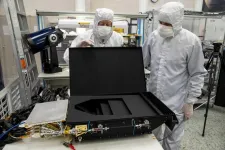(Press-News.org) Scientists have simulated conditions that allow hazy skies to form in water-rich exoplanets, a crucial step in determining how haziness muddles observations by ground and space telescopes.
The research offers new tools to study the atmospheric chemistry of exoplanets and will help scientists model how water exoplanets form and evolve, findings that could help in the search for life beyond our solar system.
“The big picture is whether there is life outside the solar system, but trying to answer that kind of question requires really detailed modeling of all different types, specifically in planets with lots of water,” said co-author Sarah Hörst, a Johns Hopkins associate professor of Earth and planetary sciences. “This has been a huge challenge because we just don't have the lab work to do that, so we are trying to use these new lab techniques to get more out of the data that we’re taking in with all these big fancy telescopes.”
The team published its findings today in Nature Astronomy.
Whether a planet’s atmosphere contains hazes or other particles has a marked influence on global temperatures, incoming levels of starlight, and other factors that can hinder or foster biological activity, the researchers said.
The team ran the experiments in a custom-designed chamber within Hörst’s lab. They are the first to determine how much haze can form in water planets beyond the solar system, Hörst said.
Haze consists of solid particles suspended in gas, and it alters the way light interacts with that gas. Different levels and kinds of haze can affect how the particles spread out through an atmosphere, changing what scientists can detect about distant planets with telescopes.
“Water is the first thing we look for when we’re trying to see if a planet is habitable, and there are already exciting observations of water in exoplanet atmospheres. But our experiments and modeling suggest these planets most likely also contain haze,” said Chao He, a planetary scientist who led the research at Johns Hopkins. “This haze really complicates our observations, as it clouds our view of an exoplanet’s atmospheric chemistry and molecular features.”
Scientists study exoplanets with telescopes that look at how light passes through their atmosphere, spotting how atmospheric gases absorb different hues or wavelengths of that light. Distorted observations can lead to miscalculations of the amounts of important substances in the air, such as water and methane, and the type and levels of particles in the atmosphere. Such misinterpretations can impair scientists’ conclusions about global temperatures, the thickness of an atmosphere, and other planetary conditions, Hörst said.
The team concocted two gas mixtures containing water vapor and other compounds hypothesized to be common in exoplanets. They beamed those concoctions with ultraviolet light to simulate how light from a star would start the chemical reactions that produce haze particles. They then measured how much light the particles absorbed and reflected to understand how they would interact with light in the atmosphere.
The new data matched the chemical signatures of a well-studied exoplanet called GJ 1214 b more accurately than previous research, demonstrating that hazes with different optical properties can lead to misinterpretations of a planet’s atmosphere.
Alien atmospheres can be very different from those in our solar system, Hörst said, adding that there are more than 5,000 confirmed exoplanets with varying atmospheric chemistries.
The team is now working to create more lab-made haze “analogs” with gas mixtures that more accurately represent what they see with telescopes.
“People will be able to use that data when they model those atmospheres to try to understand things like what the temperature is like in the atmosphere and the surface of that planet, whether there are clouds, how high they are and what they are made of, or how fast the winds go,” Hörst said. “All those kinds of things can help us really focus our attention on specific planets and make our experiments unique instead of just running generalized tests when trying to understand the big picture.”
Other authors include Michael Radke and Sarah E. Moran, of Johns Hopkins; Nikole K. Lewis, of Cornell University; Julianne I. Moses of Space Science Institute; Mark S. Marley of University of Arizona; Natasha E. Batalha of NASA’s Ames Research Center; Eliza M.-R. Kempton of University of Maryland, College Park; Caroline V. Morley of the University of Texas at Austin; Jeff A. Valenti of the Space Telescope Science Institute; and Véronique Vuitton of Université Grenoble Alpes.
END
Alien haze, cooked in a lab, clears view to distant water worlds
2023-11-27
ELSE PRESS RELEASES FROM THIS DATE:
Deoxygenation levels similar to today’s played a major role in marine extinctions during major past climate change event
2023-11-27
Scientists have made a surprising discovery that sheds new light on the role that oceanic deoxygenation (anoxia) played in one of the most devastating extinction events in Earth’s history. Their finding has implications for current day ecosystems – and serves as a warning that marine environments are likely more fragile than apparent.
New research, published today in leading international journal Nature Geosciences, suggests that oceanic anoxia played an important role in ecosystem disruption and extinctions in marine environments during the Triassic–Jurassic mass extinction, ...
Fish IgM structure sheds light on antibody evolution, study finds
2023-11-27
Antibodies—proteins that are produced by our immune system to protect us—are crucial for recognizing and getting rid of unwanted substances, or antigens, in our body. Although their role is universal, antibody structure varies in different animals. In a new study, researchers have analyzed the antibody Immunoglobulin M in rainbow trout to shed some light on why these proteins may have evolved over time.
In humans, IgM consists of five repeating units that are held together by a joining chain, resulting in a star shape. Consequently, IgM can bind to multiple antigens at the ...
Wind and solar projects can profit from bitcoin mining
2023-11-27
ITHACA, N.Y. – Bitcoin mining is often perceived as environmentally damaging because it uses huge amounts of electricity to power its intensive computing needs, but a new study demonstrates how wind and solar projects can profit from bitcoin mining during the precommercial development phase — when a wind or solar farm is generating electricity, but has not yet been integrated into the grid.
The findings suggest some developers could recoup millions of dollars to potentially invest in future renewable energy projects.
The ...
Vampire bats make northward flight seeking stable climates
2023-11-27
Vampire bats may soon take up residence in the United States and bring with them an ancient pathogen.
“What we found was that the distribution of vampire bats has moved northward across time due to past climate change, which has corresponded with an increase in rabies cases in many Latin American countries,” said Paige Van de Vuurst, a Ph.D. student in Virginia Tech’s Translational Biology, Medicine, and Health Graduate Program.
Van de Vuurst is the lead author of research recently published in the Ecography journal that predicts ...
New method uses crowdsourced feedback to help train robots
2023-11-27
To teach an AI agent a new task, like how to open a kitchen cabinet, researchers often use reinforcement learning — a trial-and-error process where the agent is rewarded for taking actions that get it closer to the goal.
In many instances, a human expert must carefully design a reward function, which is an incentive mechanism that gives the agent motivation to explore. The human expert must iteratively update that reward function as the agent explores and tries different actions. This can be time-consuming, inefficient, ...
Study shows price discounts on healthful foods like vegetables and zero-calorie beverages lead to an increase in consumption of these foods
2023-11-27
Dietary food intake has a major influence on health indicators, including Body Mass Index (BMI), blood pressure, serum cholesterol and glucose. Previous research has shown that decisions to purchase specific food items are primarily based on taste and cost. In the United States, only 12 percent and 10 percent of adults meet fruit and vegetable intake recommendations, respectively. Since affordability of food items is a limiting factor for meeting fruit and vegetable intake guidelines, researchers hypothesize that more affordable low energy-dense foods like fruits and vegetables, which are relatively more expensive ...
New platform solves key problems in targeted drug delivery
2023-11-27
In recent years, cell and gene therapies have shown significant promise for treating cancer, cystic fibrosis, diabetes, heart disease, HIV/AIDS and other difficult-to-treat diseases. But the lack of effective ways to deliver biological treatments into the body has posed a major barrier for bringing these new therapies to the market — and, ultimately, to the patients who need them most.
Now, Northwestern University synthetic biologists have developed a flexible new platform that solves part of this daunting delivery problem. Mimicking natural ...
Schrum and Sleeter unpacking the history of higher education in the United States
2023-11-27
Kelly Schrum, Professor, Higher Education Program; Affiliated Faculty, History and Art History, and Nathan Sleeter, Research Assistant Professor, History and Art History, Roy Rosenzweig Center for History and New Media (RRCHNM), received $220,000 from the National Endowment for the Humanities for the project: "Unpacking the History of Higher Education in the United States."
This funding began in Oct. 2023 and will end in late Dec. 2024.
The history of higher education is central to understanding its present and future, especially for students in Higher Education and Student Affairs (HESA) programs who will lead colleges and universities for decades ...
SwRI-led PUNCH mission advances toward 2025 launch
2023-11-27
SAN ANTONIO — November 27, 2023 —On November 17, 2023, the Polarimeter to UNify the Corona and Heliosphere (PUNCH) mission achieved an important milestone, passing its internal system integration review and clearing the mission to start integrating its four observatories. Southwest Research Institute leads PUNCH, a NASA Small Explorer (SMEX) mission that will integrate understanding of the Sun’s corona, the outer atmosphere visible during total solar eclipses, with the “solar wind” that fills and defines the solar system. SwRI is also building the spacecraft and three of its five instruments.
“This ...
SMART researchers pave the way for faster and safer T-cell therapy through novel contamination-detection method
2023-11-27
Traditional sterility testing methods for the presence of bacteria and fungi in T-cell cultures are time-consuming, taking from seven up to 14 days, while this novel method takes only up to 24 hours
Researchers combined advanced long-read nanopore sequencing techniques and machine learning to ensure accuracy and speed in detecting and identifying sample sterility status and microbial species present in T-cell cultures
This breakthrough has the potential to transform sterility assurance in biopharmaceutical manufacturing, leading to better patient outcomes by accelerating the process of getting ...









